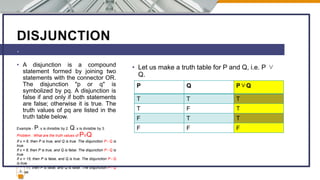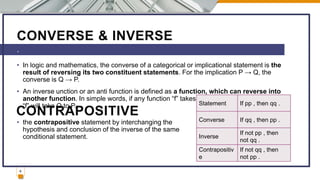BARSA-PRESENTATION.pptx
- 2. CONJUNCTION âĒ A conjunction is a compound statement formed by joining two statements with the connector AND. The conjunction "p and q" is symbolized by Pâ§Q . A conjunction is true when both of its combined parts are true; otherwise it is false. . 2 âĒ Let us make a truth table for P and Q, i.e. P ⧠Q. P Q Pâ§Q T T T T F F F T F F F F Example : P: The number x is odd. Q: The number x is prime. Problem: Can we list all truth values for R ⧠S in a truth table? Why or why not? If x = 3, then P is true, Q is true. The conjunction P ⧠Q is true. If x = 9, then P is true, Q is false. The conjunction P ⧠Q is false. If x = 2, then P is false, Q is true. The conjunction P ⧠Q is false. If x = 6, then P is false, Q is false. The conjunction P ⧠Q is false.
- 3. DISJUNCTION âĒ A disjunction is a compound statement formed by joining two statements with the connector OR. The disjunction "p or q" is symbolized by pq. A disjunction is false if and only if both statements are false; otherwise it is true. The truth values of pq are listed in the truth table below. Example - P: x is divisible by 2. Q: x is divisible by 3. Problem : What are the truth values of PâĻQ If x = 6, then P is true, and Q is true. The disjunction PâĻQ is true. If x = 8, then P is true, and Q is false. The disjunction PâĻQ is true. If x = 15, then P is false, and Q is true. The disjunction PâĻQ is true. If x = 11, then P is false, and Q is false. The disjunction PâĻQ is false. . 3 âĒ Let us make a truth table for P and Q, i.e. P âĻ Q. P Q PâĻQ T T T T F T F T T F F F
- 4. IMPLICATION âĒ An implication is the compound statement of the form âif p, then q.â It is denoted âĒ p â q, which is read as âp implies q.â It is false only when p is true and q is false, and is true in all other situations. . 4 âĒ Let us make a truth table for P and Q, i.e. P â Q. P Q PâQ T T T T F F F T T F F T
- 5. BI-IMPLICATION âĒ A bi-conditional statement, sometimes referred to as a bi- implication, may take one the following forms: P if and only if Q. P is necessary and sufficient for Q. If P then Q,and conversely. . 5 âĒ Let us make a truth table for P and Q, i.e. PâQ. P Q PâQ T T T T F F F T F F F T
- 6. CONVERSE & INVERSE âĒ In logic and mathematics, the converse of a categorical or implicational statement is the result of reversing its two constituent statements. For the implication P â Q, the converse is Q â P. âĒ An inverse unction or an anti function is defined as a function, which can reverse into another function. In simple words, if any function âfâ takes P to Q then, the inverse of âfâ will take Q to P. . 6 CONTRAPOSITIVE Statement If pp , then qq . Converse If qq , then pp . Inverse If not pp , then not qq . Contrapositiv e If not qq , then not pp . âĒ the contrapositive statement by interchanging the hypothesis and conclusion of the inverse of the same conditional statement.







